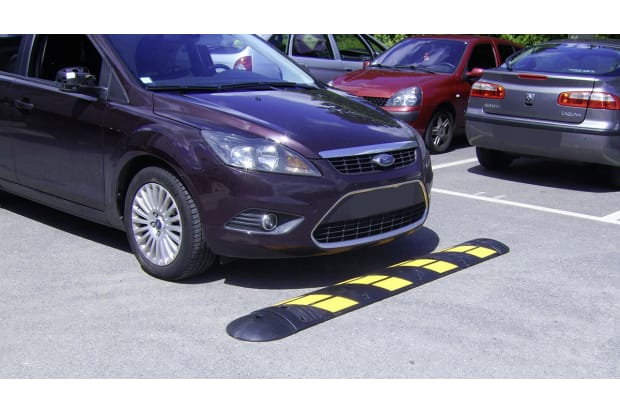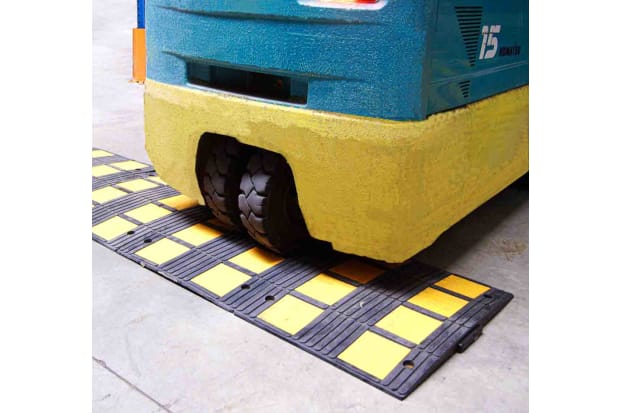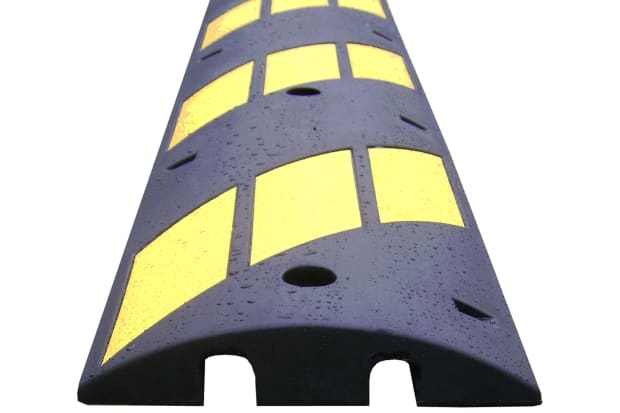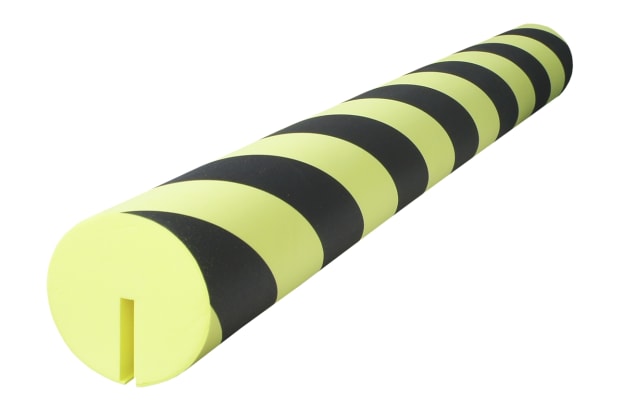- Published 11 Jan 2023
- Last Modified 29 Aug 2023
- 11 min
Speed Bumps - A Complete Guide
Our guide is designed to help you understand the different types of speed bumps and relevant UK regulations.

If you are buying temporary speed ramps or road bumps to install yourself, it is important to know which kind to use, and where. With that in mind, this guide is designed to help readers tell the difference between bumps, ramps, tables, and speed cushions.
We will explain what each product type does and highlight the various sorts of temporary speed bumps for sale online, looking at some popular designs and materials. We will also explore their proper uses across a range of private, industrial and commercial settings.
Towards the end of the guide, we will take a brief look at the relevant UK speed bump regulations you might need to know about. These will largely concern the legal uses, approved placement locations, and correct installation of temporary road humps and other traffic management products.
After reading, you should have a good understanding of how to choose the best temporary speed restricting products for your particular needs.
What are Speed Bumps?
Speed bumps are a widely used measure for slowing traffic in a particular area. Numerous different types can be found in countless locations all over the world. The main aim of installing permanent or temporary humps is to make high-risk zones safer for pedestrians and drivers alike.
They are commonly known by many different names, including speed ramps, road humps, sleeping policemen, and speed cushions. While these terms are often used interchangeably, most of them refer to distinct categories of traffic-calming measures.
Types of Speed Bumps

Speed humps and bumps are a widespread traffic-calming or speed restriction measure, with countless formats sold online in the UK and elsewhere. By choosing the right styles and materials, you will often find them a cheap and effective solution for slowing motorists down.
For this reason, permanent (fixed) or temporary (removable) humps are seen as a simple, affordable way to encourage safer driving. In particular, temporary road bumps are now increasingly popular for reducing average vehicle speeds on private property.
You will sometimes see them sold as speed inhibitors, speed breakers, or various other related names. This is reflective of the many distinct types available and you should familiarise yourself with the key differences.
Speed Humps
Speed humps are among the most basic and widely used varieties of traffic calming measures in the UK and overseas. You will find them in countless locations, from public and private roads to commercial and industrial premises, car parks and campuses.
They tend to be fairly shallow in profile, and shaped like a smooth, raised, elongated mound. They are often referred to as speed ramps, reflecting their relatively gentle angle. They normally extend widthways across most of the lane or driveway they are placed on. However, they don’t usually quite reach fully from kerb to kerb. This improves safety and convenience for cyclists, pedestrians, wheelchair users, trolleys, and so on.

Temporary speed humps are often modular, meaning they can be bought in sections to span the desired width. In areas where two lanes of traffic pass one another, installation may be staggered across opposing lanes. This is done to provide easier access for emergency services or wider vehicles. It also helps to eliminate any major chokepoints as drivers on each side slow down.
Speed humps are almost always made from plastic or rubber. This can sometimes include recycled materials. They are designed to be secured to the underlying concrete or asphalt surface using fixing bolts or anchors. These bolts will pass through pre-drilled holes in the body of the plastic. They will often be supplied as part of the product package.
Good quality temporary humps are also sold in a range of high visibility designs. Alternating black and yellow sections are a common option. Built-in reflective studs (cat’s eyes) may also be an included feature on more advanced safety models.
They are generally recommended for use in areas where the standard driving speed would normally be somewhere between 15-30mph. They are designed to be effective in reducing actual driving speeds to around 5-10mph. Good examples of places they might be used include residential streets, invited entrances, estates and campuses.
Speed Bumps
Speed bumps are very similar to humps. The main difference is that they tend to be more aggressively profiled, for increased effectiveness in slowing traffic. This means that speed bumps will have a steeper rise and tighter curvature to them than humps or ramps. They are often narrower front to back than a gentler, more gradual ramp.
Just like with humps, self-installed or temporary bumps are usually made from plastic or rubber. This is frequently manufactured using a modular design, for flexibility of width. They should also be fixed onto a solid concrete or asphalt surface using anchors or bolts. These are often included in the package and they are usually secured by passing the bolt through pre-drilled holes in the plastic body.
Speed bumps are recommended for use in areas where the standard driving speeds would already be no more than about 5-15mph. They aim to be effective in reducing actual speeds to around 2-5mph. As such, temporary bumps are a more aggressive form of traffic calming system than humps or ramps. Common examples of areas where speed bumps are used include car parks, private driveways, and entrance areas.
Speed Tables
A speed table is a slightly different installation to either a bump or a ramp. Speed tables in the UK tend to be trapezium (trapezoid) shaped, meaning they have angled sides with a flattened top.
Speed tables are a longer and wider version of a speed ramp, which is why they are often called a flat top hump. They are usually installed to fill the entire width of a roadway. The flattened zone of a speed table is often deep and wide enough to allow the full wheelbase of a passing vehicle to sit on top. Where suitable markings and lights are added, they can often double as a raised pedestrian crossing.
A table is generally a less aggressive form of traffic calming. It is similar to a ramp, but with a milder impact on vehicle speed and ride quality. Speed tables are used for slightly reducing average speeds in places where more aggressive measures could cause a delay. For this reason, they are often located in busy areas with high traffic flow, such as at or near junctions.
Speed Cushions
Speed cushions are a series of smaller individual speed ramps or humps, placed side by side. They are usually positioned across the full width of a road, but with gaps left between them. Speed cushions can vary in severity from fairly mild to quite aggressive, depending on the location and necessary speed reduction.
The idea behind speed cushions is that, by spacing them apart width-ways, most vehicles will be forced to slow down. The spacing between speed cushions is planned such that consumer cars, trucks and SUVs can’t drive over them without one or both wheels coming into contact with a hump. Vehicles with a wider wheelbase - including many models of fire engines, ambulances and buses - should, in theory, be able to drive at higher speeds through the gaps. For greater flexibility in this regard, you will sometimes see an even smaller speed cushion positioned in the centre of a two-lane road, straddling the dividing line.
Speed cushions are much more common in the UK and Europe than in North America. This is because more domestic vehicles in the US and Canada have a wide enough wheelbase to drive through them unhindered.

Cable Speed Bumps
Slowing traffic isn’t the only purpose of a cable speed bump. That is why you will regularly see them sold as roadway cable protectors or cable ramps. As the name implies, these products are equally about safeguarding cabling runs. Cable bumps are usually found installed on driveways, car parks and construction sites - anywhere that ducting or wiring has to cross the path of vehicles.
Many temporary speed restriction products will already have cable grooves cut into the underside, or recessed along the top. 27mm or 30mm are common widths for cable channels in speed ramps but other options may also be available.
In many locations, the main reason for installing these units is to reduce vehicle impact on wiring and sheathing, rather than to slow traffic. In this case, you can often save money by opting for a cheaper cable-specific solution for driveways and building sites. These will be less effective as a speed control measure than a dedicated road hump but should keep the cabling runs protected.
Fixed vs Temporary Speed Bumps
There are numerous advantages to temporary (removable) vs. fixed or permanent solutions.
Removable versions offer far greater flexibility. Being able to take them up whenever you like is ideal for moving worksites and other development areas. It is also handy in situations where you need a short-term fix, perhaps while awaiting a more permanent solution. Portable speed bumps can offer a very practical and low-cost solution for one-off events like trade shows and festivals, too.
Removable models are less of a commitment. They are perfect if you are uncertain about how effective they will prove to be, or whether you will be entirely happy with them once installed. If you change your mind at any point, you can simply swap them out at no extra cost. This is great in many types of private premises, where you don’t necessarily want to permanently change the look or functionality of an area.
Removable speed bumps are far cheaper and easier to install. Many permanent versions are made from asphalt or poured concrete, which can be expensive to buy and difficult to work with or remove. Accurate placement of permanent traffic calming measures involves expertise, heavy machinery, and of course, full knowledge of all legal requirements.
What are Temporary Speed Bumps Made from?

Most are made from plastic, rubber, or some combination of the two. In many cases, they may be sourced partly (or entirely) from recycled materials.
Plastic speed bumps and portable rubber speed bumps are both cost-effective and durable methods of manufacture, which will stand up well against even heavy traffic. Another advantage of recycled plastic or rubber speed humps is that they can be designed in various high-visibility colourways, for added safety. In particular, it is common for rubber speed ramps to have additional visibility features like cat’s eyes (reflectors) pre-installed.
Fittingly, it is quite common for temporary recycled rubber versions to be made from repurposed car tyres. This makes good sense, as they are less likely to damage current tyres than some alternative materials. They are also already resistant to all the various weathers, chemicals, oils, acids and greases that hard-wearing tyres are built for, meaning that they will be just as durable and long-lasting.
Speed Bump UK Regulations
As you might expect, there are plenty of rules, regulations and guidelines in place when it comes to installing DIY or temporary traffic-calming measures in the UK.
Laws governing private property or owned rights of way are different than those for public highways and commons. Speed restriction systems in the latter areas are overseen at varying UK Government (Department for Transport) and local council levels.
Most uses on public roads are legislated by the England and Wales Highways (Road Humps) Regulations 1999, subject to dozens of clauses and sub-clauses. This means that you cannot install temporary speed ramps on a public road.
Temporary Use on Private Property
It is advisable to check with your local council before carrying out any traffic calming measures on private land. You should also ensure that any products you do install are temporary and entirely removable if necessary.
Below, you will find a list of additional important notes and considerations to bear in mind. These should all apply in every case, even when you are considering installing temporary humps on a completely private road or fully owned area.
Specifications and Requirements
- Products of this type may only be installed on roads with an official speed limit of 30pmh or less
- If the speed limit is above 20mph, there must be street lighting. Even where this is not the case, it is always recommended to position humps as close to a source of illumination as possible
- On streets with speed limits above 20mph, you will need to provide adequate signage, following the relevant highway authority regulations
- Severe bumps designed to reduce traffic speed to less than 10mph can only ever be used on private roads
- Minimum and maximum dimensions are crucial to observe accurately. In most cases, they must be a minimum of 900mm wide and 25mm high, but no more than 100mm at their tallest point. You cannot have a vertical face (a step) of more than 6mm in height anywhere on the main body of the ramp or bump
They can’t typically be installed:
- Within 30 metres of a designated pedestrian crossing
- Within 20 metres of any part of a railway level crossing
- Within 2 metres of a pedestrian support rail or guidance rail
- Within 25 metres of a bridge or over-road crossing
General Obligations and Consultations
- You will likely need to consult with police and emergency services in the local area, to confirm that no through routes or access ways are affected
- You will likely also need to consult with other user groups, such as refuse collection and public transport services, traders, and nearby residents groups
- If your private road is shared by other people, you will need to consult with all of them and gain unanimous approval in writing before starting any work
Cautions
- Incorrectly placed speed bumps can make traffic more dangerous
- Be aware of all possible outcomes from slowing traffic in a given area, including the likelihood of increased air pollution, noise, higher vehicle upkeep costs, and the potential impact of traffic being diverted elsewhere
- Note that you may be entirely liable for any damages, injuries or other claims linked to temporary traffic calming measures on your private property
Related Products
Traffic Cones
Traffic cones are markers used to warn road users of hazards and safely redirect traffic. Shop our full range of traffic cones.
Impact Protectors
Impact protectors provide quick and easy methods of protection for edges and corners. Useful and practical, shop impact protectors for your business.

